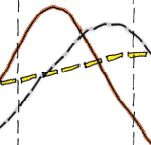- Home
- Site Analysis
- Site Use
- Passive Design
- Water
- Material Use
- Energy
- Wet Areas
- Health and Safety
- Other Resources
Passive Design
Designing the building and the spaces within it to benefit from natural light, ventilation and even temperatures.
How thermal mass works
Thermal mass works by absorbing heat and reradiating it as temperatures drop.
On this page:
- density and thermal mass
- rate of stored heat dissipation
- thermal lag
By utilising the thermal mass of a heavyweight material, temperature fluctuations can be reduced, resulting in a more constant indoor temperature.
Thermal mass is most effective when the diurnal temperature range (the temperature difference between day and night) is at its largest. Most New Zealand climates have a comparatively small diurnal temperature range.
Density and thermal mass
High density materials such as concrete, brick, tiles, earth and water require a lot of heat to increase in temperature. They also lose heat slowly and are referred to as having high thermal mass.
Low density, lightweight materials such as timber or timber products require little heat to increase in temperature but lose heat rapidly. These are referred to as low thermal mass materials.
A material suitable for thermal mass must have:
- high heat capacity
- high density
- low reflectivity (i.e. a dark, matt or textured finish).
Note that thermal mass is not the same as insulation, which, in building terms, describes a building’s ability to reduce the conduction (or flow) of heat between indoors and outdoors. In effective house designs, thermal mass and insulation work in harmony.
Rate of stored heat dissipation
The period of time that thermal mass is able to retain heat for depends on the time the mass is not able to be heated and the level of insulation. Without high levels of insulation (a minimum of SNZ PAS 4244:2003 Insulation of lightweight-framed and solid-timber houses ‘Best’ level), the stored heat indoors dissipates quickly.
The rate of dissipation is dependent on factors such as the:
- outdoor ambient temperature
- amount of insulation in the building envelope
- amount of thermal mass and stored energy
- levels of air infiltration or draughts.
Thermal lag
Thermal lag is the name given to the delay in the stored heat being released from the massive material as the ambient temperature falls. The thermal lag of a material depends on the:
- heat capacity of the material
- conductivity of the material.

- How thermal mass evens out temperature fluctuations
By alternately storing and releasing heat, high thermal mass materials can very effectively even out the daily indoor temperature extremes, effectively providing free winter-time heating when the thermal mass is exposed to direct solar gains.
Updated: 17 January 2017

